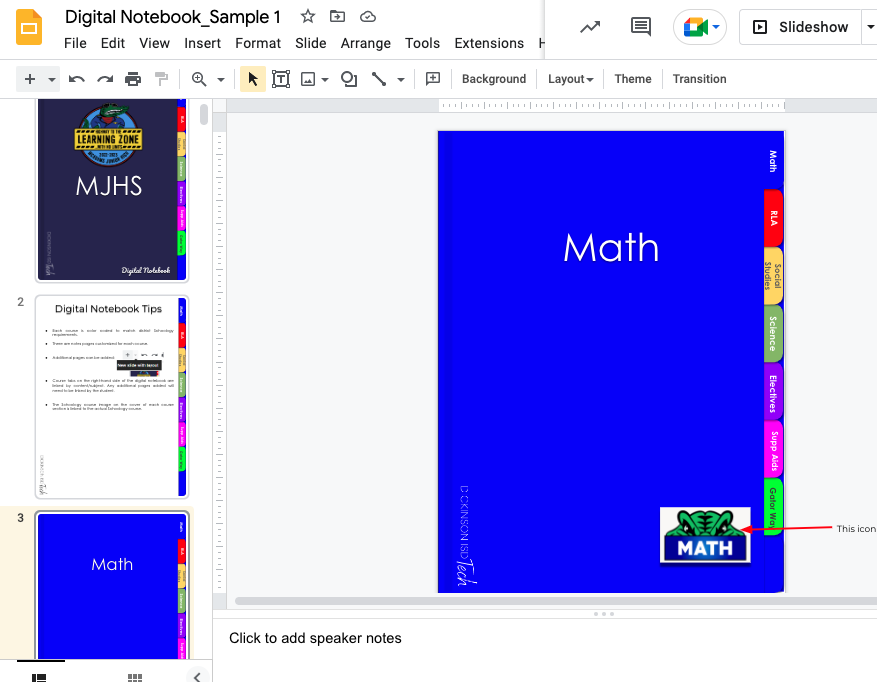Students and teachers finally return to face-to-face learning to what is a seemingly “normal” start of the 2022-2023 school year. While there is not a hard and fast definition for “blended learning,” oftentimes educators struggle with student experiences and expectations in this regard. In the spring of 2020, those in education, both students and teachers alike, were thrust into a digitally immersed classroom. There were learning curves and positive outcomes, but there were also experiments and failures across all grade and content areas. Since then, students are accustomed to being greatly immersed in technology-rich lessons and activities. And they are embracing the ever-changing technology tools available. While educators have also seemingly embraced available technology, the learning curve is still there. In my district, digital interactive notebooks are paving the way for student success across the curriculum.
What Are Interactive Digital Notebooks?
Interactive digital notebooks are an innovative way for students to engage with and organize course material. Digital notebooks can be individually assigned to students or to the class as a whole. It may seem odd to have a class notebook; however, there are important lessons that students can learn through them. And for teachers, there are many different tools you can use to incorporate digital components. When first using interactive digital notebooks, it may take a little getting used to. But you quickly become accustomed to the ease of grading and appreciate not having to lug a bunch of heavy journals home. Let’s explore a couple of detailed examples!
Digital Notebooks for Literature Circles
During the height of the pandemic, and with lots of trial and error, as the technology integration specialist in my district, I designed an interactive digital notebook for AP English IV students to use with their literature circles. They learned about digital citizenship, hyperlinking, and several other skills that are needed for college and career readiness. I worked closely with the classroom teacher and the students to ensure all the components worked properly and student expectations were clear. It was exciting to see all participants eagerly engaged in feedback! Additionally, the digital notebook could be tweaked at a moment’s notice. The students were even invited to speak about their experience with interactive digital notebooks in front of school board of education members at the TASB Governance Camp (Texas Association of School Boards) in the spring of 2022.
Here is an example for you to explore:

Interactive Notebooks as Planners
Seeing student success and excitement while interacting with the digital notebooks made me want to take another step. I went further to provide the digital notebook to students for daily use instead of a paper planner. This would allow the students to stay organized while also allowing teachers and instructional interventionists the opportunity to utilize assistive technology to support student learning and success. Not only is the notebook easy to access, but students also commented on how their backpacks stayed cleaner and more organized, too. The notebook’s main tool was Google Slides, but also incorporated Google Sheets for class calendar access. Hyperlinks bridged connectivity and access for students and parents from home to the campus classroom. My district currently uses Schoology as our Learning Management System (LMS). The teachers are becoming more and more familiar with hyperlinking homework, calendar events, interactive tools, etc., to the digital notebook.
Take a look at this example for middle school:

Digital Notebooks Increase Accessibility
There are many pros to using a digital notebook. For example, students have the ability to access their digital notebooks from virtually anywhere in the world. They just need to sign in using their school Google account. In addition to accessibility, there are also assistive technology tools within the Google Suite that students can use. Some of these tools include text-to-speech, voice typing, translation, and many others. Because there are numerous tools that can be incorporated into digital notebooks, occupational therapists in my district work with technology integration specialists to utilize assistive technology tools to ensure accommodations are effectively utilized. A couple of the main tools used outside of the Google Suite are Snap&Read and Co:Writer. Another great resource is an app called Slides Translator. It is user-friendly and includes over 60 language dialects.
Student Voice
When rolling out a project such as interactive digital notebooks, student voice is imperative when it comes to measuring success. I held a debriefing session with AP English students to take note of what worked and what did not.
Interactive Digital Notebook Templates
There are many wonderful websites that generously share their Google Slides journal templates. Some of the most notable are Slides Mania, Slides Carnival, Slides Go, and My Perfect Presentation. These sites offer a variety of templates to choose from, with several being journal-type options.
There is much to be said about the effectiveness of using interactive digital notebooks in the classroom. Both students and teachers will be positively impacted by the learning opportunities and use of technology they would not experience with a traditional paper journal. The personalization of student learning makes the trial and errors worth it in the end. The beauty of the interactive digital notebook is that one size doesn’t always fit all, but with a couple of clicks and tweaks, the notebook is perfect for the end user, the student.


7 comments
Thank you for sharing these and the pointer to so many great slide template resources.
Just FYI – it looks like the links for the two different samples are the same (both bring me to the Middle School example).
Could you share the link to the AP Lit example – I am interested to see the difference!
Thank you for bringing this to my attention! I fixed the link, and here it is for easy access. Have a great day!
Both notebook links take you to sample notebook 1. Can you please fix the link to the AP lit circle notebook (sample 2)? I would love to see that one up close!
So sorry about that. It is fixed in the article, and here it is for easy access!
Thank you for sharing, I will be showing it to my EB students.
Thank you for this resource. I think I am going to incorporate some of these into my teaching this year.
Thank you for sharing, my buggiest takeaway way is remembering that it is crucial to allow students to alternately teach and share with one another what they have discovered, what they enjoyed, and why. It is crucial for students to communicate their opinions during the learning process. The video of the student made this very evident for me. No matter how you choose to use interactive notebooks with your students, the key is to empower students to decide what they want to add and how they want to do it.